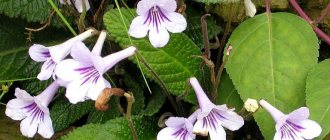Uzambara violet “Summer Twilight” is a delightful masterpiece by Konstantin Morev.
As a child, Konstantin went to visit his housemate, the famous breeder Boris Makuni. The beauty he saw struck the boy. The talented student took up the selection like a real researcher. Dear readers!
For you, we have created communities on social networks in which useful articles and interesting ideas are published several times a day! Subscribe and receive useful content in a convenient format! Famous varieties of Morev are “Frosty Cherry”, “Baby Mermaid”, “Pink Watercolor”, “Stars of Crimea” and dozens of others. “Summer Twilight” is a bright variegated variety loved by many gardeners, created in 2007.
Description of the Moreva variety
Let's take a closer look at the variety.
Leaves
The “Summer Twilight” variety forms a neat, medium-sized flat rosette.
The leaves are green, slightly concave, quilted.
There is a white border along the edge of the leaves, capturing the cloves and a small part of the leaf, as in the photo on the right; this is one of the varietal characteristics.
Flowers
Saintpaulia flowers are large double and semi-double stars 5-6 cm in diameter.
The color combines blue-violet petal centers with a white background.
The petals are velvety with a wavy edge, the flower is voluminous and lush, which is clearly visible in the photo on the left.
The short, strong peduncles sag a little under the weight of the flowers.
The variety blooms abundantly and for a long time. Even young rosettes are blooming. Violet is very elegant and creates a lyrical mood.
Peculiarities
The “Summer Twilight” variety is easy to care for and blooms successfully even for beginners.
Grows well both on a shelf and on a windowsill. The white tips of the leaves are susceptible to sunburn, so the violet is shaded from the hot sun.
The variety tolerates heat, but will show best growth and foliage color in a cool place. In hot weather, variegation decreases.
Distinctive features
Its flowers are distinguished by clear strokes, high stability of the variety parameters, and mainly works on the creation of a multi-color type of varietal violets. Many of his developments are worthy competition to innovations in US breeding. Neat small rosettes, close to ideal, in combination with lush heads of flowers of the most incredible shades and their combinations. Morev's flowers are long-lasting, bloom well and last for a long time.
The main directions of selection are the breeding of variegated rosettes, tricolor violets, and violets with a colorful contrasting border. Morev spends a long time and patiently testing all its varieties for stability of parameters. This is the special quality of flowers called “Moreva violets”
The violet is also interesting because, as an ideal habitat, it requires exactly the same climatic indicators as for healthy human existence. If your violet is sick, this is a signal for you too. Perhaps it is too cold or hot, dry or too wet, too little or too much light.
Photo of violet “Summer Twilight”
Growing conditions
Let's consider the basic conditions for growing the variety.
Priming
Most gardeners use ready-made peat-based soils. Popular mixtures are Greenworld (preferred) and Saintpaulia.
The soil is sieved, separating large pieces and fibers. Then sterilize in a steaming pan or in the microwave for 10-15 minutes.
After the soil has cooled, loosening agents are added to it: perlite or vermiculite. Loosening agents are needed to prevent the soil from caking and allow air to reach the delicate roots.
The ratio of soil and loosening agents is approximately as follows:
- 2 parts peat soil;
- 1 part baking powder with a predominance of perlite.
For violets on wick watering, the proportion of baking powder increases. Many gardeners make up their own soil mixture, adding leaf soil, moss, coconut fiber and other ingredients.
Important! The soil must be sterilized and the additional components washed well.
Pot
Plastic pots for violets are preferable to ceramic ones. They do not cool the roots, are not clogged with salts, are easy to clean and leave the ground easier.
Attention! Size matters! The diameter of the pot should not exceed 1/3 of the diameter of the rosette.
The Saintpaulia root system is not able to absorb a large volume of soil. Overflow and acidification of the soil occurs. For the Summer Twilight variety, a 7-12 cm pot is sufficient.
Lighting
Saintpaulia "Summer Twilight" needs soft, diffused light 10-12 hours a day.
Excessive lighting is indicated by crowding and drooping leaves.
The best location in summer is a northern window sill. You can shade the plants with gauze folded in half, paper or a non-woven tablecloth.
A lack of light is indicated by pale leaves, elongated petioles and weak peduncles. Use backlights or move the violet closer to the window.
Detailed description of other varieties on our website: violet “Blue Dragon”, violet “Cinderella’s Dream”, violet “Esmeralda”, violet “Lituanica”, violet “Ice Rose”, violet “Olesya”, violet “Blue Fog”, violet “Chanson” ", violet "Jan Minuet" and others
Temperature
Violet “Summer Twilight” grows comfortably at a temperature of 22-25 C°. In a cool, bright room, the variegation of leaves is brighter and the blue in the color of flowers is richer. High temperatures cause growth to slow down and the center of the rosette becomes clogged.
Reference! At temperatures above 26 C°, photosynthesis in Saintpaulia slows down and the violet stops growing.
Humidity
Violet can suffer from dry air both in the summer heat and in winter.
During the battery operating season, air humidity drops to 20-30%. An ultrasonic humidifier or indoor greenhouse will help increase humidity.
Hobbyists successfully use lattice trays, into the lower part of which water is poured. Evaporation works better if expanded clay soaked in water is placed in the tray. This method of moistening is also used for wick irrigation. The only difficulty is adding water to the pan in time.
Violet SM-Petersburg (Moreva Seedling)
Charming violet St. Petersburg.
Authorship of the variety
One of the leading experts in the development of new varieties of Saintpaulia, Konstantin Lvovich Morev, during his breeding research, obtained a nice variety with a bright finger-colored corolla.
But the Moscow master of the domestic breeding school did not consider it possible to admit the new violet to the varietal registration procedure, since it did not show stable results when passing through numerous stages of testing.
K. Morev became interested in growing Uzambara violets and creating new decorative varieties of them after meeting the recognized master of violet growing B. M. Makuni.
As a true professional who has been dealing with this topic for three decades, he is distinguished by :
- Deep knowledge of the physiological processes of tropical beauties;
- And also an extremely responsible attitude towards the selection of candidates for the title of “varietal Saintpaulia”.
This variety was created by Konstantin Morev.
Attention! The “rejected” violet has settled in the collections of flower growers under the abbreviation “SM” (Morev’s seedling) and has regularly appeared at exhibitions since 2006.
Taxonomy
The “SM-Petersburg” violet, following the official hierarchical rules of taxonomic periodization of botanical objects, is distributed in the tacitly assigned to it status of “seedling” to a genus that is multifaceted in color and silhouette, incredibly representative in the number of variations included in it and inimitable in its decorative characteristics. Saintpaulia (from the Gesneriev family):
- Seedling bushes belong to the standard section according to the average values of their overall diametrical coefficients;
- And to the finger subspecies based on the method of coloring flower petals.
The variety belongs to the standard subspecies.
Photo and description of the variety
The seedling, which is part of the group of “independent” violets in terms of development, does not need the help of flower growers in the process of forming their bushes. This quality is an additional bonus when violet growers choose the next Saintpaulia for their collection.
Violet, as its leaf plates grow, is able to arrange them in a neat sequence in tiers , forming fairly dense rosettes of a flattened structure. The spatial contours of the instances have:
- Symmetrical pattern;
- And relative compactness.
Important! Due to the size of its overall shape, the seedling is included in the group of the standard subspecies, but with regular care and correctly calculated regimes, its specimens are able to greatly outgrow the numerical indicators of the boundaries of this group - the rosette begins to occupy large areas without losing its decorativeness and neat appearance.
Medium-sized violet leaves are characterized by :
- Round or oval - elongated configuration (which depends on the color variation of the seedling);
- Brightly colored shade of summer green;
- Softly extruded venation graphics;
- And a smooth, matte surface, dotted with a mass of small fibers.
The edges of the leaf are decorated with clearly cut, rounded teeth and most often curve downwards.
The variety in question has leaves that grow downwards.
In most specimens, the leaves sit on elongated petioles , due to which the violet acquires its large size. Above you can see a photo of the Petersburg Moreva violet.
The seedling is different:
- Very early first flowering;
- Large volumes of caps during subsequent flowerings;
- And the large size of the corollas, which remain in decorative splendor for a long time.
The flowers, in their shape, belong to the “star” subspecies , filled with petals from single to semi-double or double stage. Stars of different sizes can bloom on a bush at the same time, but more often there is one type of flower. The wavy edges of the petals give the seedling flowers a slightly curly texture and increase their volume.
The seedling represents the finger group of Saintpaulias and is painted white with two types of color prints decorating its corollas. The spots occupying the central part of the petals can be:
- Available in pink shades of varying intensities;
- Or painted with cherry and burgundy colors with brownish reflections.
The flowers have a delicate color.
Important! A negative feature of the seedling is the gradual fading of the rich color of the flowers, which become very pale towards the end of their life span.
Sports
When describing a seedling, one cannot talk about its sporting behavior, since sports can only appear in varietal violets that have a documented description by the author. The seedling does not have such a description, so it is correct to consider only variable changes in the color of its flowers.
In the seedling, in addition to the division into pink and brownish-red shades in the tonality of the finger spots, there are two color variations without obvious spotting :
- With white corollas, slightly shimmering with pink illumination;
Sports white. - With pink-crimson flowers.
Pink sport violet.
Planting and propagation
“Summer Twilight” is a variegated variety. For cuttings we choose the healthiest, greenest leaves - they are more viable.
Leave the petioles 4-5 cm long and lightly dry the sections.
For planting, we take small pots with a diameter of 5 cm or plastic cups. We make drainage holes.
We paste the labels. Place some moss on the bottom. Pour steamed soil with the addition of perlite into the pots and spill with Fitosporin solution.
We plant the cuttings in pots one at a time, at a slight angle to a depth of 1 centimeter. Place in a greenhouse and transfer to a bright place with a temperature of about 25 °C.
How to choose a place
Like any other violet, Darling should be periodically watered and fed. In addition, in order for the plant to bloom profusely and always be healthy, you should choose the right place for it. Darling is a violet that absolutely does not tolerate drafts. When choosing a place for it, you should definitely take this into account.
Actually, the room itself in which this violet is grown should be quite warm. The optimal temperature for Darling in room conditions is 18-25 °C. At night this figure can decrease by 5 °C. These flowers usually tolerate such short-term cold snaps without any harm to themselves.
Of course, these violets will feel best on the windowsill. Darling prefers east or west windows in her rooms. This variety needs good lighting. However, its leaves should not be exposed to direct sunlight. Determining how correctly the lighting was chosen for Darling is quite simple. All you need to do is just watch the flower a little. If its leaves stretch upward on long cuttings, it means that it does not have enough lighting. An excess of ultraviolet radiation leads to the fact that the violet rosette begins to turn pale. At the same time, the leaves themselves characteristically curl downwards.
Violet care
Care includes the following procedures.
Watering
Watering violets is the most important element of care.
Carefully! The plant should not be flooded, but at the same time the violet is afraid of drying out.
Typical watering mistakes:
- Abundant watering in drafts and cold weather;
- Bay of violets in a heavy, caked substrate;
- Overdrying followed by abundant watering when the root hairs have already died.
It is more correct to water a little with soft water when the top layer of soil dries out. The wick method of watering helps to avoid fluctuations in humidity.
Transfer
The plant is replanted when the rosette outgrows the diameter of the pot by 2-3 times.
A larger pot with drainage at the bottom is filled with soil. We insert the previous pot in the middle, then carefully remove it and place the violet in the resulting hole.
Replanting with soil replacement is used in the following cases:
- Withering violets;
- Damage, soil acidification.
Remove the violet from the pot and shake off the soil from the roots. Rotten roots are removed. The rest are dusted with charcoal. The violet is planted in loose soil, and after a few hours it is watered with a solution of Fitosporin.
Fertilizer and feeding
Saintpaulia responds well to fertilizers, but overfeeding is dangerous for violets. Balanced liquid fertilizers with a solution of vermicompost cause the least harm. The concentration is taken to be half that in the instructions. Violets are fed during the growth period - from April to September.
Diseases and pests
Saintpaulias are susceptible to fungal, bacterial diseases and pest attacks.
The reasons lie in improper care - flooding, drying out, drafts, sunburn.
When attacked by pests - mites, thrips or mealybugs, the affected plant is isolated and treated with the Fitoverm insecticide.
Fusarium affects the entire plant starting from the roots. The violet fades irreversibly. The plant is destroyed, the pot is disinfected with copper sulfate.
Powdery mildew is a common disease. The plant is treated with fungicide Skor.
If the roots rot, the only way to save the violet is by re-rooting the top or a healthy leaf. Prevention of the disease - reducing watering, spilling the soil with Fitosporin. In cold weather, violets are not sprayed; water should not get on the leaves.











